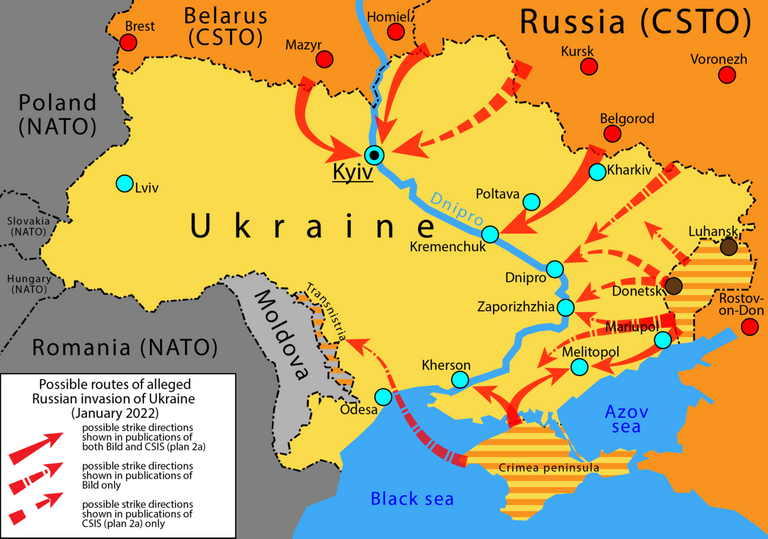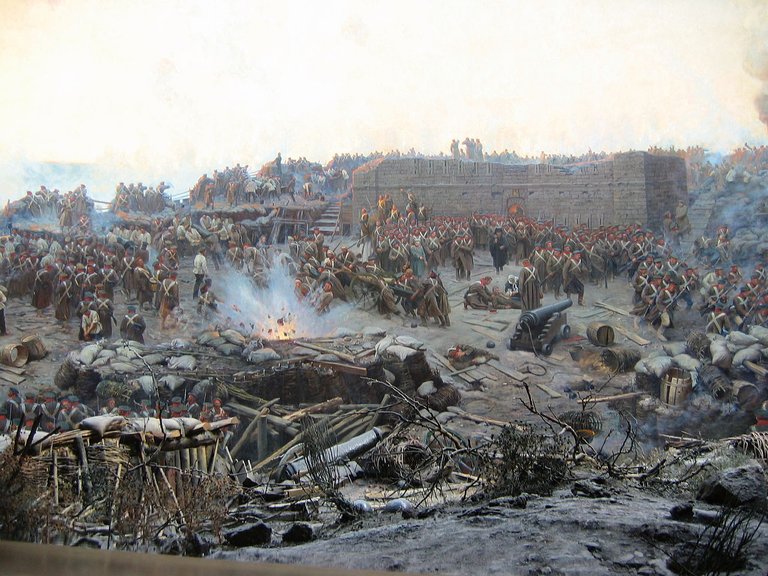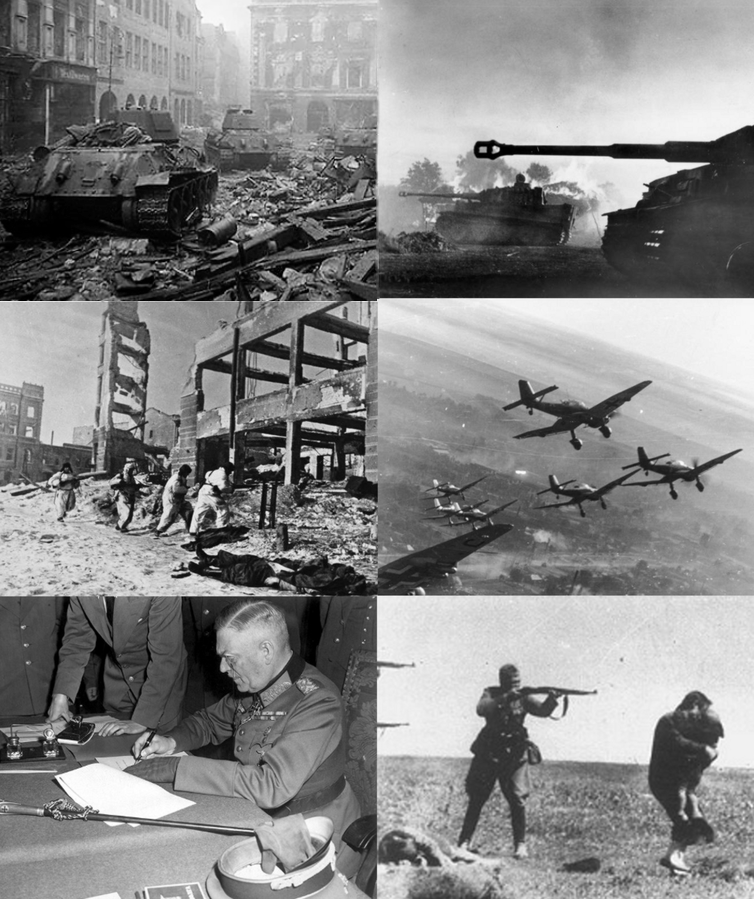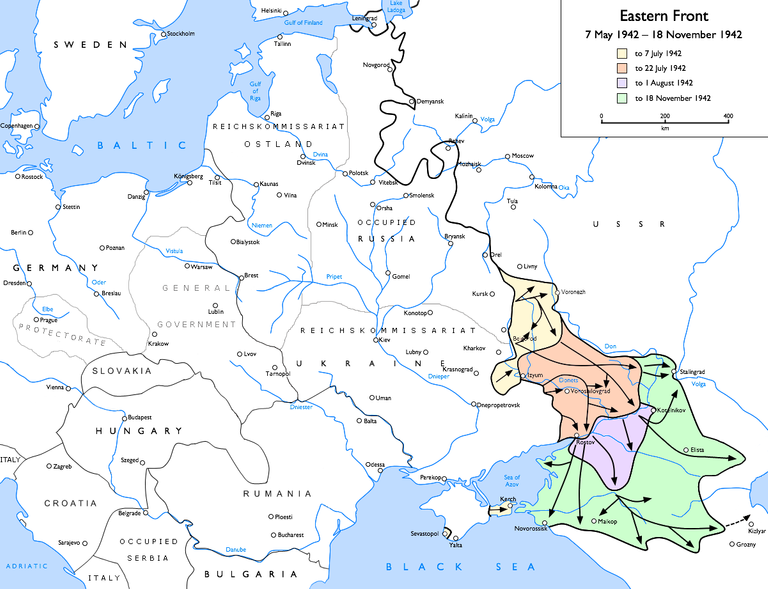 Map showing two alleged Russian plans published separately by Bild[120] and the Center for Strategic and International Studies (CSIS).[121]
Map showing two alleged Russian plans published separately by Bild[120] and the Center for Strategic and International Studies (CSIS).[121]
In March and April 2021, Russian president Vladimir Putin ordered the Russian military to begin massing thousands of personnel and equipment near its border with Ukraine and in Crimea, representing the largest mobilization since the annexation of Crimea in 2014.[38][39] This precipitated an international crisis and generated concerns over a potential invasion. Satellite imagery showed movements of armour, missiles, and heavy weaponry.[40][41] The troops were partially withdrawn by June 2021,[42] but the crisis was renewed in October and November 2021, when over 100,000 Russian troops were massed around Ukraine on three sides by December.[43]
The crisis stemmed from the protracted and ongoing Russo-Ukrainian War and the War in Donbas, which began in 2014. In December 2021, Russia advanced two draft treaties that contained requests for what it referred to as "security guarantees", including a legally binding promise that Ukraine would not join the North Atlantic Treaty Organization (NATO) as well as a reduction in NATO troops and military hardware stationed in Eastern Europe, and threatened unspecified military response if those demands were not met in full. NATO has rejected these requests, and the United States warned Russia of "swift and severe" economic sanctions should it further invade Ukraine.[44] The crisis was described by many commentators as one of the most intense in Europe since the Cold War.[45][46][47]
On 21 February 2022, Russia officially recognised the two breakaway regions in eastern Ukraine, the Donetsk People's Republic and the Luhansk People's Republic, as independent states, and deployed troops to Donbas, in a move interpreted as Russia's effective withdrawal from the Minsk Protocol.[48][49] The breakaway republics were recognised in the boundaries of their respective Ukrainian oblasts, which extend far beyond the line of contact.[50] On 22 February, Putin said that the Minsk agreements were no longer valid.[51] On the same day, the Federation Council unanimously authorised the use of military force in the territories.[52]
On the morning of 24 February, Putin announced that Russia was initiating a "special military operation" in the Donbas, and launched a full-scale invasion into Ukraine.
Currently, as Russia invades Ukraine, the United States and Western Europe are forming a siege against Russia. Some argue that World War III will break out, but I have a different opinion.
I think Putin wants a revival of the USSR.
My esteemed senior @roleerob has always been advising me about the misunderstandings and mistakes my awkward English speaking skills can bring.
I always appreciate his kind advice, but as the saying goes, failure is the mother of success, I will continue to take on reckless challenges.
I am sure that my many failures and challenges will eventually lead to my greatest success.😄
I wonder what kind of critique my German friend @v-siniarski would give to the fact that an East Asian man like me write about European history.
 Detail of Franz Roubaud's panoramic painting Siege of Sevastopol (1904)
Detail of Franz Roubaud's panoramic painting Siege of Sevastopol (1904)
The Crimean War[e] was a military conflict fought from October 1853 to February 1856[4] in which Russia lost to an alliance of France, the Ottoman Empire, the United Kingdom and Piedmont-Sardinia. The immediate cause of the war involved the rights of Christian minorities in Palestine, which was part of the Ottoman Empire. The French promoted the rights of Roman Catholics, and Russia promoted those of the Eastern Orthodox Church. Longer-term causes involved the decline of the Ottoman Empire, the expansion of the Russian Empire in the preceding Russo-Turkish Wars, and the British and French preference to preserve the Ottoman Empire to maintain the balance of power in the Concert of Europe. It has widely been noted that the causes, in one case involving an argument over a key,[5] had never revealed a "greater confusion of purpose" but led to a war that stood out for its "notoriously incompetent international butchery".[6]
The churches worked out their differences with the Ottomans and came to an agreement, but both French Emperor Napoleon III and Russian Emperor Nicholas I refused to back down. Nicholas issued an ultimatum that demanded the Orthodox subjects of the Ottoman Empire be placed under his protection. Britain attempted to mediate and arranged a compromise to which Nicholas agreed. When the Ottomans demanded changes to the agreement, Nicholas recanted and prepared for war.
In July 1853, Russian troops occupied the Danubian Principalities[4] (now part of Romania but then under Ottoman suzerainty). In October 1853, having obtained promises of support from France and Britain, the Ottomans declared war on Russia.[7] Led by Omar Pasha, the Ottomans fought a strong defensive campaign and stopped the Russian advance at Silistra (now in Bulgaria). A separate action on the fort town of Kars, in Western Armenia, led to a siege, and an Ottoman attempt to reinforce the garrison was destroyed by a Russian fleet at the Battle of Sinop in November 1853. Fearing an Ottoman collapse, the British and the French had their fleets enter the Black Sea on 3 January 1854.[8] They moved north to Varna in June 1854 and arrived just in time for the Russians to abandon Silistra. Aside from a minor skirmish at Köstence (now Constanța), there was little for the Allies to do.
Frustrated by the wasted effort and by the demands for action from their citizens, the allied commanders decided to attack Russia's main naval base in the Black Sea, Sevastopol, on the Crimean Peninsula. After extended preparations, allied forces landed on the peninsula in September 1854 and marched their way to a point south of Sevastopol after they had won the Battle of the Alma on 20 September 1854. The Russians counterattacked on 25 October in what became the Battle of Balaclava and were repulsed, but the British Army's forces were seriously depleted as a result. A second Russian counterattack, at Inkerman (November 1854), ended in stalemate as well. The front settled into the Siege of Sevastopol, involving brutal conditions for troops on both sides. Smaller military actions took place in the Baltic (1854–1856; see Åland War), the Caucasus (1853–1855), the White Sea (July–August 1854) and the North Pacific (1854–1855).
Sevastopol finally fell after eleven months, after the French had assaulted Fort Malakoff. Isolated and facing a bleak prospect of invasion by the West if the war continued, Russia sued for peace in March 1856. France and Britain welcomed that development, as the conflict was growing unpopular at home.
The Treaty of Paris, signed on 30 March 1856, ended the war. It forbade Russia from basing warships in the Black Sea. The Ottoman vassal states of Wallachia and Moldavia became largely independent. Christians there gained a degree of official equality, and the Orthodox Church regained control of the Christian churches in dispute.[9]
The Crimean War was one of the first conflicts in which military forces used modern technologies such as explosive naval shells, railways and telegraphs.[10] The war was one of the first to be documented extensively in written reports and in photographs. As the legend of the "Charge of the Light Brigade" demonstrates, the war quickly became a symbol of logistical, medical and tactical failures and of mismanagement. The reaction in Britain led to a demand for professionalisation, most famously achieved by Florence Nightingale, who gained worldwide attention for pioneering modern nursing while she treated the wounded.
The Crimean War marked a turning point for the Russian Empire. The war weakened the Imperial Russian Army, drained the treasury and undermined Russia's influence in Europe. The empire would take decades to recover. Russia's humiliation forced its educated elites to identify its problems and to recognise the need for fundamental reforms. They saw rapid modernisation as the sole way to recover the empire's status as a European power. The war thus became a catalyst for reforms of Russia's social institutions, including the abolition of serfdom and overhauls in the justice system, local self-government, education and military service.
I studied the Crimean War of the 19th century, when European empires and the Russian Empire were at war.
After taking the Black Sea from the Ottoman Empire, the Russian Empire went to war to advance into the Mediterranean Sea.
If the Russian fleet were to enter the Mediterranean, the British and French empires that had dominated the Mediterranean would be challenged by Russia.
So, the British and French empires formed an alliance with the Ottoman Empire and then went to war with the Russian Empire.
In the end, Russia was defeated by the advanced weapons, equipment and technology of Britain and France.
The Crimean War exposed the fact that the Russian Empire was backward and weaker than Western Europe, and eventually the Russian Empire collapsed.
As a result of the war, Russia lost the Russian fleet's sailing rights in the Black Sea and admitted that it was inferior to Western Europe.
As the Russian Empire, which had won the Napoleonic Wars in the past, suffered a humiliating defeat by Western European empires, Russia was humiliated as a backward country in Europe.
From then on, the Russian Empire was always one step behind Britain, France and Germany in the European hegemony.
https://en.wikipedia.org/wiki/Industrialization_in_the_Russian_Empire
Industrialization in the Russian Empire saw the development of an industrial economy, whereby labor productivity increased and the demand for industrial goods was partially provided from within the empire. Industrialization in the Russian Empire was a reaction to the industrialization process in Western European countries.
The first steps related to accelerating the development of industry were taken during the reign of Peter I. However, the beginning of the introduction of machine production in leading industries and vehicles was in the second quarter of the 19th century. This period is considered to be the beginning of the industrial revolution in Russian Empire.[by whom?] The industrialization process continued until 1917. Later in the years of Soviet industrialization. Russia was in the role of catching up, trying to catch up with the advanced countries of the West in terms of industrial development.
So, the Russian Empire started the Industrial Revolution to catch up with Western Europe.
Certain industries of the Russian Empire were characterized by extremely rapid growth. From 1894 to 1914, in the Russian Empire, coal production increased by 306%, oil - by 65% (growth stopped in 1901, since then no increase has been observed), gold - by 43%, copper - by 375%; cast iron - by 250%; iron and steel - by 224%. Russia supplied 50% of world egg exports; it owned 80% of the world production of flax.[12]
At the beginning of the 20th century, the Russian Empire, along with the United States, occupied a leading position in world agriculture. This is especially evident in the example of grain crops: in the first 14 years of the 20th century, the sown area increased by 15%, grain yield by 10%, grain harvest per capita by more than 20%.[13] Gross grain harvest - 5637 million poods (92.5 million tons) - 1 place in the world (half the world rye crop, second place in wheat harvest), as well as 1 place in grain export - 647.8 million poods were exported (10.61 million tons) of grain.[14] The total volume of grain exports amounted to 651 million rubles. Russia ranked 1st in the production and export of butter (77576 tons of butter exported).[15]
At the same time, in terms of per capita GDP, the Russian Empire did not belong to world leaders. GDP per capita, calculated in 1990 Giri-Khamis international dollars, in the Russian Empire in 1913 was $1,488 per person with a world average of $1,524, which was below the level of all European countries except Portugal, and approximately corresponded to the level of Japan and the average Latin America level. GDP per capita was 3.5 times lower than in the United States, 3.3 times lower than in the UK, 1.7 times lower than in Italy[16]
After the Industrial Revolution, Russia was able to grow into one of the world's five most industrialized countries at the beginning of the 20th century. However, Russian industry and capital were dominated by the United States and Western Europe. Russia was outwardly a European power, but internally it was an economic colony of the United States and Western Europe.
https://en.wikipedia.org/wiki/History_of_Russia_(1892%E2%80%931917)
Under Tsar Nicholas II (reigned 1894–1917), the Russian Empire slowly industrialized repressing opposition in the economic center and on the far-left. During the 1890s Russia's industrial development led to a large increase in the size of the urban middle class and of the working class, which gave rise to a more dynamic political atmosphere[citation needed] and the development of radical parties. Because the state and foreigners owned much of Russia's industry, the Russian working class was comparatively stronger and the Russian bourgeoisie comparatively weaker than in the West. The working class and the peasants became the first to establish political parties in Russia, because the nobility and the wealthy bourgeoisie were politically timid.[citation needed]
During the 1890s and early 1900s, bad living- and working-conditions, high taxes and land hunger gave rise to more frequent strikes and agrarian disorders. These activities prompted the bourgeoisie of various nationalities in the Russian Empire to develop a host of different parties, both liberal and conservative. By 1914, 40% of Russian workers were employed in factories of 1,000 workers or more (32% in 1901). 42% worked in businesses of 100 to 1,000 workers and 18% in businesses of 100 workers or fewer (in 1914, the United States had equivalent figures of 18%, 47% and 35%, respectively).[1]
Politically, anti-establishment forces organized into competing parties. The liberal elements among the industrial capitalists and nobility, who believed in peaceful social reform and a constitutional monarch, founded the Constitutional Democratic party or Kadets in 1905. Radical factions had their own parties. The workers in major cities revolted in 1905 with widespread strikes and mutinies. The Tsar barely kept control, promised an elective parliament (the Duma) and the revolt subsided. However, the Tsar then dissolved the Duma (1906). He turned to Peter Stolypin (Prime Minister from 1906 to 1911) to reform the huge but sluggish economy.
Nicholas II's foreign policy centred on an alliance with France and involved increased meddling in Balkan affairs. Russia proclaimed a role for itself[when?] as military protector of Orthodox Christians, notably those in Serbia. Efforts to expand Russian power in the Far East led to a short war with Japan in 1904–1905, which ended in humiliating defeat for St Petersburg. The Russians blundered into World War 1 in 1914 without realizing the risks. With few exceptions, the government proved incompetent and the Imperial Russian Army suffered heavy losses. Eventually, liberal elements conducted the February Revolution in 1917 as the radicals like Vladimir Lenin bided their time, largely working through soviets in the factories and in the army.
These internal problems in Russia exploded with World War I. As Russia was a backward industrial country dependent on the capital and technology of the United States and Western Europe, it could not withstand the economic pressures of World War I and collapsed.
 The Soviet Union after World War II
The Soviet Union after World War II
The Soviet Union,[m] officially the Union of Soviet Socialist Republics[n] (USSR),[o] was a socialist state that spanned Eurasia during its existence from 1922 to 1991. It was nominally a federal union of multiple national republics;[p] in practice its government and economy were highly centralized until its final years. The country was a one-party state (prior to 1990) governed by the Communist Party of the Soviet Union, with Moscow as its capital within its largest and most populous republic, the Russian SFSR. Other major urban centers were Leningrad (Russian SFSR), Kiev (Ukrainian SSR), Minsk (Byelorussian SSR), Tashkent (Uzbek SSR), Alma-Ata (Kazakh SSR) and Novosibirsk (Russian SFSR). It was the largest country in the world, covering over 22,402,200 square kilometres (8,649,500 sq mi), and spanning eleven time zones.
After the collapse of the Russian Empire, the Soviet Union was born.
The European empires and the United States had a serious confrontation with the Soviet Union, which eventually led to World War II.
 Clockwise from top left: Soviet T-34 tanks storming Berlin; German Tiger I tanks during the Battle of Kursk; German Stuka dive bombers on the Eastern Front, December 1943; Ivanhorod Einsatzgruppen photograph of German death squads murdering Jews in Ukraine; Wilhelm Keitel signing the German Instrument of Surrender; Soviet troops in the Battle of Stalingrad
Clockwise from top left: Soviet T-34 tanks storming Berlin; German Tiger I tanks during the Battle of Kursk; German Stuka dive bombers on the Eastern Front, December 1943; Ivanhorod Einsatzgruppen photograph of German death squads murdering Jews in Ukraine; Wilhelm Keitel signing the German Instrument of Surrender; Soviet troops in the Battle of Stalingrad
The Eastern Front of World War II was a theatre of conflict between the European Axis powers against the Soviet Union (USSR), Poland and other Allies, which encompassed Central Europe, Eastern Europe, Northeast Europe (Baltics), and Southeast Europe (Balkans) from 22 June 1941 to 9 May 1945. It was known as the Great Patriotic War in the Soviet Union and some of its successor states, while everywhere else it was called the Eastern Front.
The battles on the Eastern Front of the Second World War constituted the largest military confrontation in history.[2] They were characterised by unprecedented ferocity and brutality, wholesale destruction, mass deportations, and immense loss of life due to combat, starvation, exposure, disease, and massacres. Of the estimated 70–85 million deaths attributed to World War II, around 30 million occurred on the Eastern Front, including 9 million children.[3][4] The Eastern Front was decisive in determining the outcome in the European theatre of operations in World War II, eventually serving as the main reason for the defeat of Nazi Germany and the Axis nations.[5]
The two principal belligerent powers were Germany and the Soviet Union, along with their respective allies. Though never sending in ground troops to the Eastern Front, the United States and the United Kingdom both provided substantial material aid to the Soviet Union in the form of the Lend-Lease program along with naval and air support. The joint German–Finnish operations across the northernmost Finnish–Soviet border and in the Murmansk region are considered part of the Eastern Front. In addition, the Soviet–Finnish Continuation War is generally also considered the northern flank of the Eastern Front.
As Hitler waged war to conquer the Soviet Union, one of the greatest and most devastating wars in human history took place. It was one of the most brutal and massive wars fought during World War II.
 Case Blue: German advances from 7 May 1942 to 18 November 1942
Case Blue: German advances from 7 May 1942 to 18 November 1942
In the Battle of Stalingrad (23 August 1942 – 2 February 1943),[16][17][18] Germany and its allies fought the Soviet Union for control of the city of Stalingrad (now Volgograd) in Southern Russia. The battle was marked by fierce close-quarters combat and direct assaults on civilians in air raids. The Battle of Stalingrad was the deadliest battle to take place during the Second World War[19] and is one of the bloodiest battles in the history of warfare, with an estimated 2 million total casualties.[20] The battle marked a turning point in the war as it forced the Oberkommando der Wehrmacht (German High Command) to withdraw considerable military forces from other theaters of war to replace their losses on the eastern front.[21] The victory at Stalingrad energized the Red Army and shifted the balance of power in the favor of the Soviets.
The Soviet Union and Germany waged a great war around the Black Sea. Hitler predicted that if the Germans conquered the Black Sea area, they could destroy the Soviet Union. However, with the Soviet victory in the Battle of Stalingrad, the fall of the German Third Reich was doomed.
The Soviet Union emerged as a superpower competing with the United States by defeating European empires in wars in the Black Sea region. After winning the war with the German Empire, the Soviet Union fought a Cold War with the United States until its collapse in 1991.
The current confrontation between Russia and US-led NATO around the Black Sea seems similar to the wars between Russia and European powers in the past.
Russia, which had been defeated in the Crimean War, was reduced to an economic colony of Europe and America.
After defeating Germany in World War II, the Soviet Union emerged as a superpower competing with the United States.
Looking at these historical events, I have come to the conclusion that Putin invaded Ukraine to revive the Soviet Union.


Perhaps the US intervened in the Ukrainian war because it wanted Russia to become a weaker power?
Or is it to achieve world peace centered on the United States?
I am looking forward to what kind of answers my two seniors I respect will give me.🤣
Ahha, Also looking forward to reply from dear my friend @v-siniarski.

All the principals involved, Putin, Zelensky, Biden, and the EU slavering over the prospect of advancing NATO to China's border are WEF. None of the public statements have anything to do with the WEF's purpose in the Ukraine conflict. The WEF is destroying the global monetary system.
Famine is the certain result.
Thanks!
Dear @valued-customer , I first heard of the World Economic Forum. In the world I live in, nothing is known about the World Economic Forum.
I will study about the World Economic Forum.
Thank you!
Globalists want us to be mad at Putin. It's a trap.
In the very limited time I have @goldgrifin007, I will simply refer you to what I have said here and here.
Dear @roleerob , I appriciate your answer! I will interpriter your answer!😃
Putin is afraid of democracy and he wants to win back his former country, Ukraine has been reacting for 30 years now and he has cut off Ukraine's raw materials areas. 😑😕
Ukraine's resources, food, and ports to the Black Sea were very important to Russia.
Yes...
Russia is a great country. The problem is that its government does not represent the will of its people.
Dear @discernente, Nice meet to you! Are you Ukrainen? I want the citizens of Ukraine and Russia to find freedom, peace and prosperity.
No, I am brazilian.
Nice meet to you! I am an east asian!😄
Nice to meet you, we are really far away.